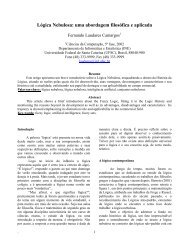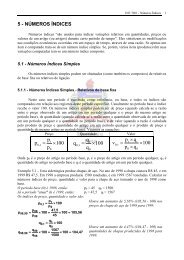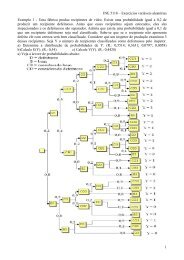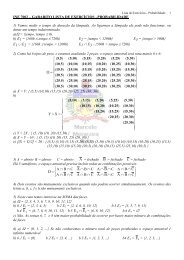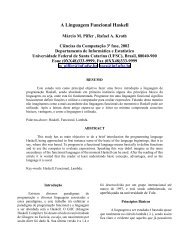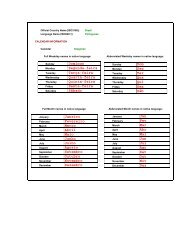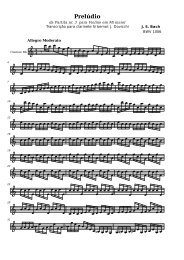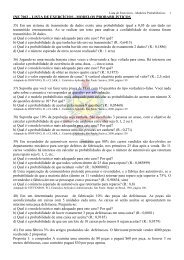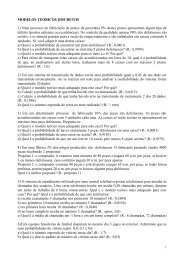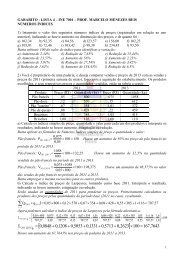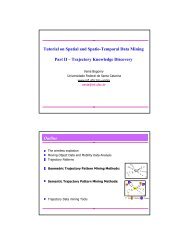Anais do IHC'2001 - Departamento de Informática e Estatística - UFSC
Anais do IHC'2001 - Departamento de Informática e Estatística - UFSC
Anais do IHC'2001 - Departamento de Informática e Estatística - UFSC
You also want an ePaper? Increase the reach of your titles
YUMPU automatically turns print PDFs into web optimized ePapers that Google loves.
<strong>Anais</strong> <strong>do</strong> IHC’2001 - IV Workshop sobre Fatores Humanos em Sistemas Computacionais 69<br />
During the planning phase, communication between the product manager (marketing) and<br />
the programming manager is established to produce the vision <strong>do</strong>cument. This artefact<br />
<strong>de</strong>fines a set of goals that drive the product <strong>de</strong>velopment. These agents also produce a high<br />
level specification for the product with a preliminary list of features to be present in the<br />
final product. The product life cycle at ORG is oriented by this vision <strong>do</strong>cument and by<br />
the high level specification.<br />
During the <strong>de</strong>velopment phase, communication between program managers and <strong>de</strong>velopers<br />
take place and the functional specification evolves as a result of this conversation.<br />
Developers have an important role in the choice of the features to be implemented. Subsets<br />
of this functionality are <strong>de</strong>fined and milestones are stated for their liberation. Each set of<br />
features liberation involves intensive communication between <strong>de</strong>velopers and testers.<br />
While <strong>de</strong>velopers write co<strong>de</strong> based on functional specification, the later test it for bugs. It<br />
is also in this phase that the interface is <strong>de</strong>signed and tested for usability problems. After<br />
the last liberation, modifications in the main interface components (menus, dialogue boxes,<br />
etc.) are not allowed anymore.<br />
During the stabilisation phase, the software product is extensively tested at ORG and<br />
outsi<strong>de</strong>, with Beta-version clients. Testers and <strong>de</strong>velopers establish communication with<br />
Beta-version clients during this phase. When high severity bugs are not found, the product<br />
is liberated to manufacturing.<br />
The different agents also establish conversation with the emergent artefact, using channels<br />
related to their function in the organisation. As examples, there is a conversation between<br />
usability engineers and the emergent interface, using inspection methods as channels;<br />
<strong>de</strong>velopers establish a conversation with the co<strong>de</strong> they are creating, through the tools they<br />
use (compilers, <strong>de</strong>bugging tools, etc.).<br />
Walking through the meta-mo<strong>de</strong>l<br />
An overview analysis of the meta-mo<strong>de</strong>l for the <strong>de</strong>sign process point to aspects of<br />
communication among the agents, which <strong>de</strong>serve further discussion:<br />
• The analysis on the meta-mo<strong>de</strong>l tells us that the process is marketing-oriented,<br />
which is consistent with the economical and cultural contexts of ORG. This is<br />
reflected in the <strong>de</strong>velopment driven by the functionality. The program manager<br />
acts as a channel between the marketing and all the other groups (<strong>de</strong>velopers,<br />
testers, <strong>de</strong>signers and usability engineers). He propagates information to<br />
<strong>de</strong>velopers and testers using the functional specification, communicating the<br />
inten<strong>de</strong>d functions for the product and the priorities to implement them. From the<br />
<strong>de</strong>veloper perspective, this is an efficient message. However, <strong>de</strong>signers and<br />
usability engineers need more elements to un<strong>de</strong>rstand how the functions should be<br />
arranged and structured in the product as a whole, <strong>de</strong>termining the user experience.<br />
On the other hand, <strong>de</strong>signers and usability engineers’ vision should be consi<strong>de</strong>red<br />
especially in the planning phase of the cycle. However, as the meta-mo<strong>de</strong>l shows,<br />
their participation is noticed only in <strong>de</strong>velopment activities (concentrated in the<br />
right part of the diagram), when the product specifications are already <strong>de</strong>fined.<br />
• The un<strong>de</strong>rstanding about the user has different meanings to different agents of the<br />
process. The meta-mo<strong>de</strong>l shows us different “users” communicating to different<br />
agents: some users participate in the usability tests, communicating to the usability



